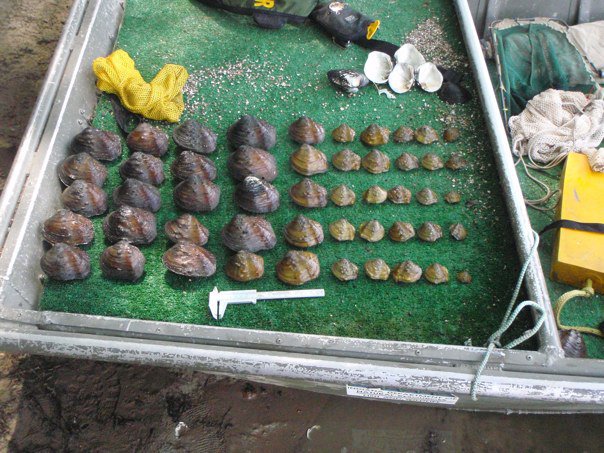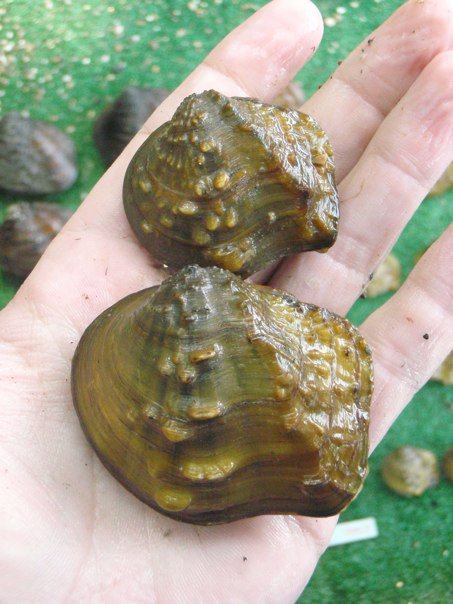ES Malacologist’s Thesis on Mapleleaf Freshwater Mussel Traces Prehistoric Entry Route to Great Lakes
 EnviroScience, Inc. would like to congratulate malacologist Phil Mathias on the publication of his Master’s Thesis in the journal Hydrobiologia. Mr. Mathias studied the genetics and phylogeography (genetic makeup across a geographic region) of the common and widespread native freshwater mussel, the Mapleleaf (Quadrula quadrula) using nuclear DNA and microsatellites for his Master of Science research at Central Michigan University (CMU; Mount Pleasant, MI). His work determined the potential entry route into the newly formed Great Lakes when the Wisconsinan glacial period ended. His thesis work using nuclear DNA recently published with a colleague’s (Jordan Hoffman) mitochondrial DNA work on the Mapleleaf in Hydrobiologia. He and his co-authors[1] worked for many years on the research for this peer-reviewed journal article and are very happy to have the data and results available for fellow researchers. This was an extremely large-scale project for a single species of mussel, and the data and results can be used as a surrogate for more imperiled freshwater mussel species with similar life histories. A summary of their research is below:
EnviroScience, Inc. would like to congratulate malacologist Phil Mathias on the publication of his Master’s Thesis in the journal Hydrobiologia. Mr. Mathias studied the genetics and phylogeography (genetic makeup across a geographic region) of the common and widespread native freshwater mussel, the Mapleleaf (Quadrula quadrula) using nuclear DNA and microsatellites for his Master of Science research at Central Michigan University (CMU; Mount Pleasant, MI). His work determined the potential entry route into the newly formed Great Lakes when the Wisconsinan glacial period ended. His thesis work using nuclear DNA recently published with a colleague’s (Jordan Hoffman) mitochondrial DNA work on the Mapleleaf in Hydrobiologia. He and his co-authors[1] worked for many years on the research for this peer-reviewed journal article and are very happy to have the data and results available for fellow researchers. This was an extremely large-scale project for a single species of mussel, and the data and results can be used as a surrogate for more imperiled freshwater mussel species with similar life histories. A summary of their research is below:
Modern day species’ distributions and the genetic makeup of that species across geographic regions often reflect pre-historic events, such as a glaciation, and can also reflect subsequent, anthropogenic alterations to the landscape. The post glacial history of the Mapleleaf was investigated and reconstructed using nuclear and mitochondrial DNA. Three hypotheses were tested to determine the colonization route of the Mapleleaf following the most recent glacial retreat that formed the present day Great Lakes. Tissue samples for genetic analyses were non-lethally collected from the Mapleleaf at sites spanning hypothesized glacial refugia and postglacial expansion routes in the Mississippi River drainage, including the Ohio and Missouri rivers, and the Great Lakes. Populations of Mapleleaf were non-lethally sampled with proper permits by extracting mantle tissue from hand-collected mussels across much of the species’ range, targeting locations in Michigan, Ohio, Indiana, Illinois, Missouri, and Ontario north and south of the Wisconsinan glacial maximum. Nearly 1,300 individual mussels were genotyped from 40 sites in 26 different rivers within both the Great Lakes (around 700 individuals) and Mississippi River (around 600 individuals) drainages from 2008 to 2010. The broad-scale phylogeography and population structure was assessed with Mr. Hoffman’s sequencing of a single mitochondrial gene (CO1) and Mr. Mathias’ genotyping of eight microsatellites. Results of analyses showed distinct differences among the Great Lakes, Mississippi River, and Ohio River drainages, and suggested colonization of the Great Lakes basin from a Mississippian source. Populations congruently showed patterns of isolation by distance: geographic and genetic distances were significantly correlated among Great Lakes populations based on colonization through the Chicago–Illinois outlet, but not when following the Wabash–Maumee outlet. All evidence indicates that postglacial colonization of the Great Lakes basin occurred almost exclusively through the Chicago–Illinois outlet, with subsequent expansion into the lower Great Lakes.
Mr. Mathias and his co-authors would like to thank their funding sources (Endangered Species Recovery Fund of World Wildlife Fund Canada, Fisheries and Oceans Canada (DFO), OMNRF, CMU, and the Conchologists of America, Inc.) for making this research possible. For their valuable assistance in both the field and lab, they would like to thank many individuals from CMU, Trent University, U.S. Geological Survey, The University of Toledo, Indiana Department of Natural Resources, Illinois Department of Natural Resources, Ohio Department of Natural Resources, Missouri Department of Conservation, Michigan Department of Natural Resources, United States Fish and Wildlife Service, OMNRF, DFO, and many friends and family.
The full journal can be found here: Mathias, P.T., J.R. Hoffman, C.C. Wilson, and D.T. Zanatta. Hydrobiologia (2016). doi:10.1007/s10750-016-3076-0. http://link.springer.com/article/10.1007/s10750-016-3076-0
[1] Jordan Hoffman and Dr. David Zanatta from the Institute for Great Lakes Research, Biology Department, CMU and Dr. Chris Wilson from the Aquatic Research and Monitoring Section, Ontario Ministry of Natural Resources and Forestry (OMNRF), Trent University, Peterborough, Ontario, Canada
